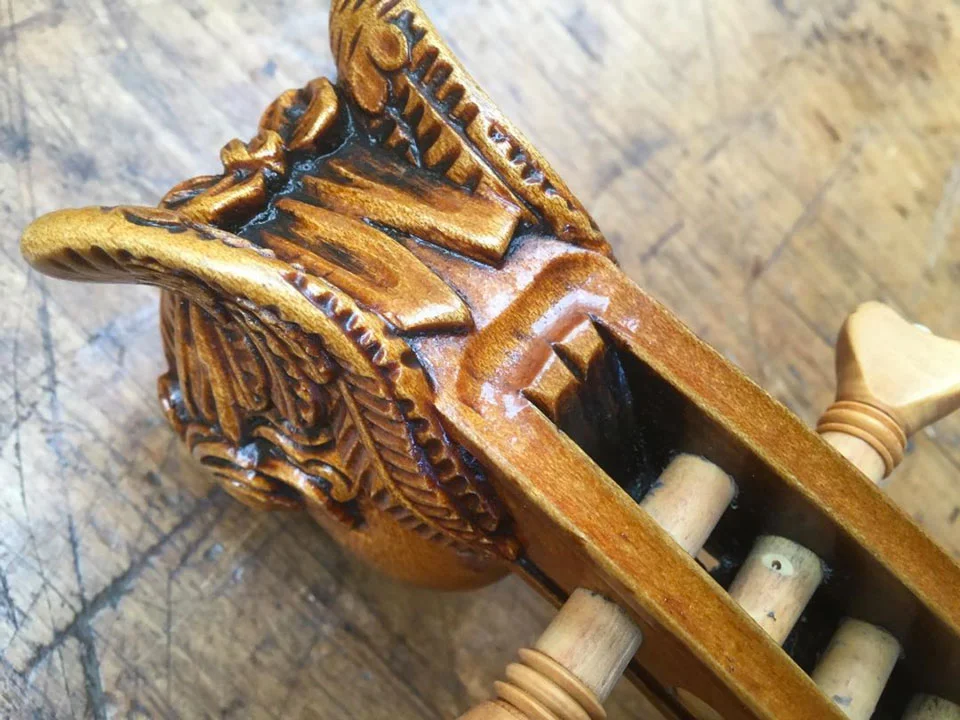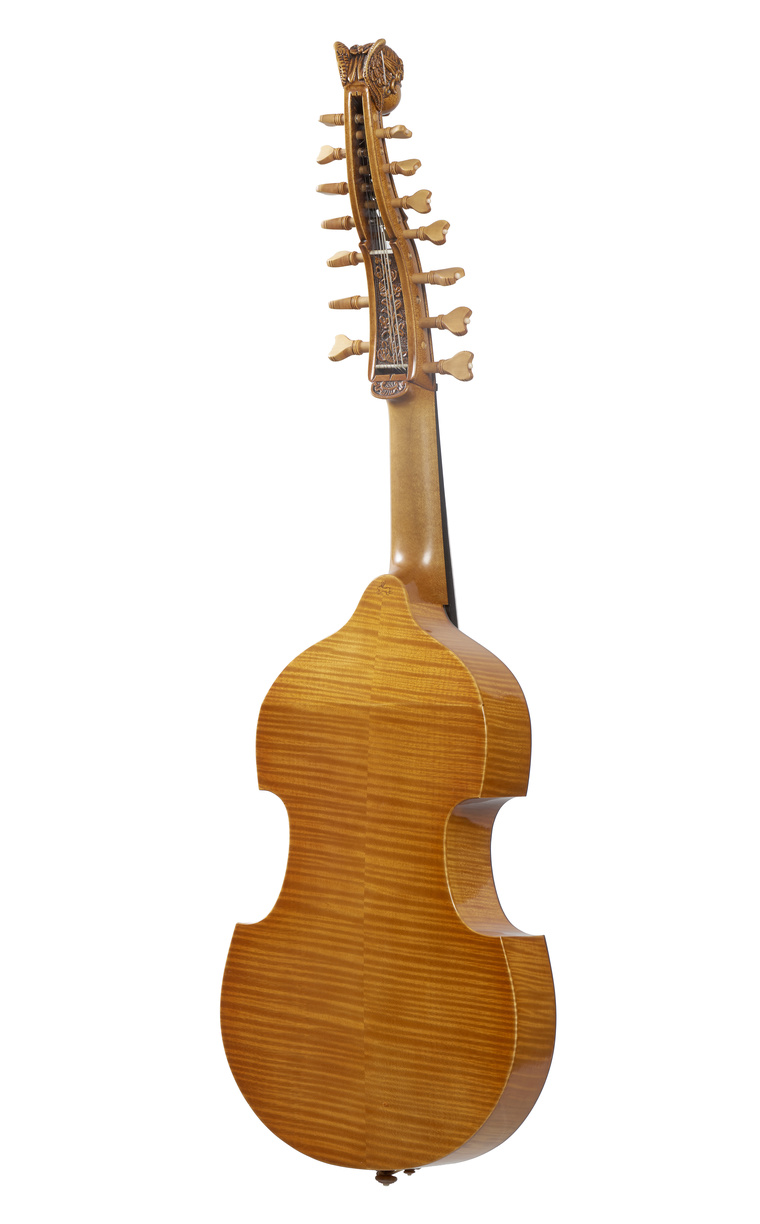7/7 Viola d’Amore by Jonathan Hill
My viola d’amore was made in 2017 by luthier Jonathan Hill.
Flamed maple back & ribs | Plain maple neck with carved blindfolded cupids head | Spruce soundboard with apple wood rosette and 'flame' sound holes | Ebony veneered fingerboard and tailpiece | Second tailpiece of solid ebony (not shown) | Boxwood pegs with bone pips | Linseed Oil & pine resin varnish | Uncovered & silver wound gut playing strings by Damian Dlugolecki | Brass/copper wound and iron sympathetics by Peter Bavington | Professional photos of the instrument by Ellen Broughton | Other instrument photos by Jonathan Hill & Clifton Harrison
I asked for an instrument that could effectively navigate the entire range of viola d’amore repertoire, from the seventeenth century right up to the present. While it is primarily configured in a ‘typical’ baroque setup with gut playing strings and wire sympathetic strings, I also requested that the instrument be able to cope with wire playing strings, various tensions, synthetic core modern strings, and anything else that I could think of. This was a big ask and Jonathan came up with this beautiful instrument. It is a convertible 7/7 to 6/6 setup. This allows the most flexibility for me.
Jonathan Hill | luthier
Maker of Viola da gamba, Viola d’amore and Violin family instruments.
Period stringed instrument maker Jonathan Hill trained in baroque/early instrument making with Shem Mackey and Roger Rose at West Dean College, U.K. where he passed with distinction. He then worked as violin maker under the direction of Roger Hansell in Yorkshire, making modern concert violin family instruments for professional musicians.
In 2013 Jonathan began working as a freelance luthier and restorer, working in a number of workshops across Europe alongside other makers including Nupi Jenner in Vienna & Renate Fink in Germany.
In 2016 he was awarded a Winston Churchill Travelling Fellowship where he travelled to Istanbul and spent some time working in the workshop of renowned Oud maker, Mustafa Copçuoğlu. Immersed in the musical life of the city, Jonathan gained a deeper insight into the cross cultural development of musical instruments as well as construction techniques relevant to his work as a period instrument maker. In Istanbul he also worked alongside Murat Yerden, a maker of the Turkish classical Kemençe, a traditional bowed instrument from the Persian & Greek region. Download Jonathan’s Fellowship report here.
In 2019 Jonathan was awarded a 'Golsoncott Foundation' bursary towards a studio at Cockpit Arts in Deptford, South East London, where his business is now based. He also teaches Instrument Making/Historic Craft Practice at West Dean College in Sussex.
How it began…
I learned to play the viola d’amore to some extent in high school. I used a modern setup 7/7 instrument. My first public performance was playing the viola d’amore solo in Puccini’s ‘Humming Chorus’ in Madame Butterfly. Later, I performed Hindemith’s Kammermusik No. 6, Op. 46 No. 1 for viola d’amore and orchestra and his Kleine Sonata for viola d’amore and piano. It wasn’t until two decades later in 2016 that I began exploring the music of Christoph Graupner (1683-1760). A contemporary of JS Bach and Telemann, Graupner composed numerous works for the instrument, including concerti, trio sonatas, cantatas, sinfonias, and ouvertures. Digging further, I discovered more and more compelling repertoire for the instrument. It was then that my fascination for the viola d’amore was renewed, this time in historical performance practice.
My quest for an instrument began by inquiring with colleagues and trying a few instruments. The stars aligned when I consulted with my friend, colleague, and stringed instrument expert Benjamin Hebbert. He suggested that I speak to Jonathan Hill. When describing his work, Ben said Jonathan is “the finest contemporary maker of viola d’amores that I have seen in many years.” Ben put me in touch. Less than year later, I had a viola d’amore!
Versatility | Bridge, Tailpiece, & Strings
Here is the bridge made by Jonathan that enables the viola d’amore to be played with either six or seven playing strings without having to re-string the entire instrument. There are notches at the top of the bridge for either setup. The lowest string (7th) is pulled down along the side of the bridge and fits into a notch especially carved for that purpose. The remaining six strings are spread and placed into their own respective notches made for the six string configuration (see below). He also made me two tailpieces, one for earlier music using gut strings (shown in the photos) and one (not shown) that is more robust so it can handle wire playing strings (with hooks) and modern synthetic core strings. The seven playing strings are by US-based historical strings maker Damian Dlugolecki. The sympathetic strings were made to Jonathan’s exacting specifications by clavichord maker Peter Bavington. The viola d’amore is most often in a baroque setup (A=415hz) yet it easily adapts to classical and modern tunings and temperaments. This is essential for my research as I explore different historical materials and practices.
Fittings | Turning & Carving
Everything on the instrument (apart from the gut and sympathetic strings) were made by Jonathan. The pegs are boxwood with bone pips. The bridge also has a bone inlay where the sympathetic strings pass through it. The tailpiece and fingerboard are ebony veneered maple. Jonathan took inspiration from two main sources; a viola d’amore by Johann Uldarichus Eberle (c. 1699 - 1768) and one by Thomas Andreas Hulinsky (1731 – 1788).



















































